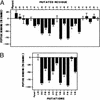A binding motif for Siah ubiquitin ligase
- PMID: 12626763
- PMCID: PMC152253
- DOI: 10.1073/pnas.0534783100
A binding motif for Siah ubiquitin ligase
Abstract
The Drosophila SINA (seven in absentia) protein and its mammalian orthologs (Siah, seven in absentia homolog) are RING domain proteins that function in E3 ubiquitin ligase complexes and facilitate ubiquitination and degradation of a wide range of cellular proteins, including beta-catenin. Despite these diverse targets, the means by which SINASiah recognize substrates or binding proteins has remained unknown. Here we identify a peptide motif (RPVAxVxPxxR) that mediates the interaction of Siah protein with a range of protein partners. Sequence alignment and mutagenesis scanning revealed residues that are important to this interaction. This consensus sequence correctly predicted a high-affinity interaction with a peptide from the cytoskeletal protein plectin-1 (residues 95-117). The unusually high-affinity binding obtained with a 23-residue peptide (K(Dapp) = 29 nM with SINA) suggests that it may serve as a useful dominant negative reagent for SINASiah proteins.
Figures





References
Publication types
MeSH terms
Substances
LinkOut - more resources
Full Text Sources
Other Literature Sources
Molecular Biology Databases
Miscellaneous

